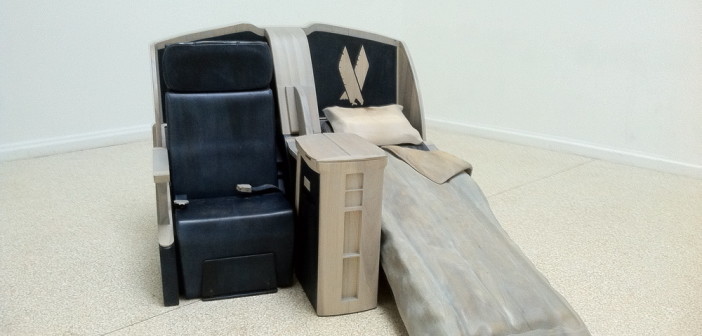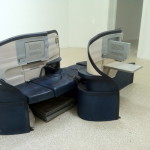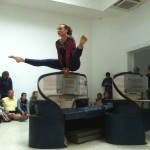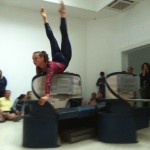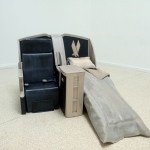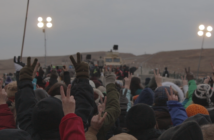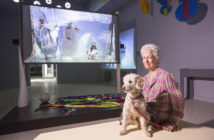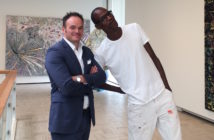The Ugly Americans1
On November 6, 2012, for the first time in its history, a majority of voters in Puerto Rico supported a non-binding referendum to become the fifty-first state of the United States of America. If the petition for statehood is recognized by the U.S. Congress, then Puerto Rico will transition from being an unincorporated territory of the United States to a full-fledged member of the Union. As if foreshadowing this historic vote, the 2011 representatives for the United States at the 54th Biennale di Venezia were San Juan based artists Jennifer Allora & Guillermo Calzadilla. When I visited the pavilion in June of that year, I had been familiar with the duo’s work, their political gestures, humorous inversions, and bizarre juxtapositions that commonly contain themes of protest and cultural critique. Witnessing their work at the Venice Biennale, a historically recognized event for the presentation of nationalism through contemporary art, provided a unique context for the artists to function as U.S. cultural diplomats.
Originally erected in 1930, the U.S. pavilion is located in the Giardini, the main exhibition area of the Venice Biennale. As with other pavilions in the Giardini, its architecture functions as a testament to national culture. The neoclassical building is reminiscent of a miniaturized version of Monticello, complete with dome and rotunda. When approaching the pavilion in 2011, I was confronted by a runner dressed in a U.S. jersey running on a treadmill on top of an overturned tank. This work, Track & Field, dominated the space in front of the Pavilion and filled the surrounding areas of the Giardini with the loud, grinding noises of the tank treads. Upon entering the building, I approached Armed Freedom Lying on a Sunbed, which consisted of a reduced bronze replica of the Statue of Freedom lying horizontally inside a Solaris 422 tanning bed. In the galleries to the right and left of the pavilion’s central rotunda, Allora & Calzadilla placed life size replicas of elite business class airline seats. These seats appeared to be worn from use, as if they are from a previous decade. Attention had been paid to minor details, such as the inclusion of a grey blanket under the seat and dog-eared copies of airline magazines slipped into the seat pockets. As I walked around the sculptures, carefully examining these details, I was reminded of my own travel experience of coming to Venice only a day before, which included a stressful and uncomfortable transatlantic flight. Even though the airline seats are only replicas, their worn appearance made them seem as if they were removed from debris of a plane crash, evoking memories of 9/11 when instruments of consumer flight were transformed into weapons of aggression and violence.
My understanding of the work was quickly complicated by the fact that these sculptures were not meant to merely serve as objects of aesthetic reflection, but function as apparatuses for gymnasts. At specified times throughout the day, a male or female gymnast dressed in glittery red, white, and blue spandex with the letters "U.S.A." across the chest presented a routine to a small audience that filled the gallery space. The female gymnast used the model of the Delta airline seat as a balance beam. Her body bends and folds along the curves of the seat, displaying trained athletic grace that defies gravity through her ability to balance on this atypical piece of equipment. The routine, which lasted approximately for 17 minutes, included movements from gymnastics combined with modern dance, emphasizing her flexibility. In the opposite gallery, a male gymnast transformed the American Airlines seat into a pommel horse, upon which he performed a twelve-minute routine that demonstrated his physical strength.
 Jennifer Allora & Guillermo Calzadilla
Jennifer Allora & Guillermo CalzadillaBody in Flight, in Gloria, 2011 Venice Biennale
Photo: EL Putnam
The airline seats both structured the space of the gallery by occupying a specific place in the room, as well as structured the routines of the gymnasts who use these seats as apparatuses. The reclining position of the seats emphasized stasis as the implied performativity of the occupant is to be in a set of rest and not in motion. What then is the "body in flight" that the title mentions? The airline seats, though static, come from commercial airlines whose logos decorate the seats. However, these seats are presented out of context, isolated in the gallery. The implied body in flight of the airplane is absent from the work. The "body in flight" must then be the body of the gymnasts—the hyper-trained athletes whose machinelike bodies bend and cut through the air in a manner unlike the average person. These nationally identified athletes performing on nationally identified airline seats in a nationally identified Pavilion at an international art festival exposes structures of the national and commercial occupation of space.
Body in Flight (American) and (Delta), along with the five other newly commissioned works constituted Gloria, Allora & Calzadilla’s exhibition at the 2011 Venice Biennale. The artist duo are known for works that incorporate a range of artistic media, including sculpture, video, sound, and delegated performance. Other works included in Gloria are the two channel video projection Half Mast\Full Mast, the performance installation Track and Field (2011), the interactive installation Algorithm, and the sculptural installation Armed Freedom Lying on a Sunbed. According to a press release sent out by the Indianapolis Museum of Art, the sponsoring institution of the pavilion, these works "re-present familiar symbols, forms, and actions to destabilize existing narratives around national identity, global commerce, international competition, democracy, and militarism."2 In addition, Gloria can also be considered a playful and horrific meditation on social practice, which includes U.S. nationalism in relation to Puerto Rico. These works exemplify how visual art can function as regional, national, and international political gestures
While each of the works contains signs, images, and icons that can be recognized as politically charged, the title of the exhibition, Gloria, frames their uptake. The use of the term "gloria," can be read in a number of ways, though in relation to United States, the "Battle Hymn of the Republic" and its refrain of "Glory, glory, hallelujah!" comes to mind. This song, penned by Boston poet Julia Ward Howe during the Civil War (1861), relates the tumultuous conflict with holy judgment at the end of time as describes in the New Testament. Howe’s daughter, Florence Howe Hall, describes how her mother wrote the lyrics (sung to the melody of the popular war song at the time, "John Brown’s Body") in a single night after visiting Union army camps.3 According to Hall, Howe was both troubled and inspired by the struggles of the Union soldiers during this era and worked actively as part of the abolitionist movement. Hence, the correlation drawn between the battlefield and God’s judgment stems from the larger fight against the "evil" that the institution of slavery represents.4 Since the Civil War, the "Battle Hymn of the Republic" has become one the United States’ classic call to arms, regularly performed by marching bands and choirs, including the Mormon Tabernacle Choir and military affiliated musical groups. After September 11, 2011, the equation of war with holy judgment effectively participates in the morally charged and rhetoric of good and evil perpetuated by the international policies of the Bush Administration: either you are with us or against us.
The presentation of U.S. nationalism is explicit in Gloria, and at times, is so extreme that it borders on being garish, especially since it brings to mind the nationalist fervor in the United States that took place after 9/11. Instead of being solely a celebration of national identity, Gloria is an opportunity for restricted dissensus, a controlled critical intervention that expresses the U.S. celebration of freedom of speech that effectively displays democratic values through criticism. When chatting with a fellow American at the pavilion, he noted that this exhibit would not have been possible under the Bush administration. After eight years of ideological fervor and culturally conservative government policies, including the implementation of the controversial Patriot Act, Gloria becomes an opportunity for the U.S. government to exhibit tolerance of dissensus. The United States Department of State approved the decision to select Allora & Calzadilla as the 2011 U.S. representatives of the Venice Biennale and provided financial support for Gloria. In a press release dated September 8, 2010, a spokesman for the Department states: "designed to offer rich opportunities for dialogue and interaction with the public, their projects will appeal to a broad audience."5 The State Department makes sure to emphasize that Allora & Calzadilla are living and working in Puerto Rico: "the work of Allora & Calzadilla… reflects the progressiveness of creativity and culture in the United States today."6 The inclusion of Puerto Rican artists contributes to an image of national diversity that has been increasingly prevalent since the election of Barack Obama in 2008, a progressive trend that has been reaffirmed by interpretations of the 2012 election. In the 2011 Venice Biennale, the United States displays a national identity that contradicts their image of the first decade of the 21st century as war mongering xenophobes. As a result, Gloria becomes an opportunity for the U.S. to salvage its cultural reputation while visually representing the democratic values that form the basis of U.S. national identity.
 Jennifer Allora & Guillermo Calzadilla
Jennifer Allora & Guillermo CalzadillaTrack and Field, in Gloria, 2011 Venice Biennale
Photo: EL Putnam
Instead of being the work of "rogue" artists, Gloria displays the paradoxical nature of democracy. French philosopher Jacques Derrida describes how democracy is a governmental system where the right to criticize is part of the paradigm: "Democracy is the only system…in which, in principle, one has or assumes the rights to criticize everything publicly, including the idea of democracy, its concept, its history and its name."7 Alain Badiou, another French philosopher, describes the leeway allowed for dissensus under the democratic emblem: "You can say what you like about political society, display unprecedented ‘critical’ zeal, denounce the ‘economic horror,’ you'll always earn pardon as long as you do so in the name of democracy."8 The use of art, even art that appears to critique the system it represents, has a use in perpetuating democratic values. In his discussion of Gloria, NPR correspondent Christopher Livesay describes how the exhibit qualifies as a tool of foreign policy that the Obama administration refers to as "soft diplomacy" or "smart power."9 The purpose of this tactic, according to David Mees, the U.S. cultural attaché in Rome, is to "cultivate [a]softer image"10 for the United States. Moreover, it is not coincidental that themes of the military and athletic competition are present in Gloria. This tactic involves the presentation of critical engagement with U.S. military policies, specifically those instigated during the Bush presidency, as a means of "softening" the image of the U.S. by presenting it as more tolerant and self-aware under President Barack Obama.
At the Venice Biennale, a lot is at stake concerning national and international relations. Like the Olympics, the Venice Biennale is about state power and national pride; an opportunity to re-affirm and potentially challenge international power relations without succumbing to armed conflict. In the nationalized and politicized context of the Venice Biennale, art comprises political gestures that participate in global cultural, economic, and social affairs. The decision by the 2011 U.S. Pavilion Commissioner, Lisa Freiman of the Indianapolis Museum of Art, to select Puerto Rican based artists as U.S. representatives in the context of the most prestigious of international biennials can be interpreted as simultaneously confirming and questioning U.S. nationalism in the twenty-first century. On the one hand, it reaffirms Puerto Rico's status as a U.S. territory, granting the artists the significant role of cultural ambassador on an international stage. On the other hand, Allora & Calzadilla disrupt impressions of U.S. nationalism by highlighting the island's ambivalent status. Puerto Rico is re-affirmed as a U.S. territory in the national imagination while also altering what constitutes U.S. nationalism. Recognition is also brought to Puerto Rico and its liminal status. Even though it is not a state, the island is included in the U.S. cultural landscape. Looking back at this decision after November 6, 2012 reaffirms the significance of this gesture.
With a June 1, 2013 opening day, preparations for the 55th Venice Biennale have been well under way for months now. Installation artist Sarah Sze has been selected as the U.S representative, with director of the Bronx Museum of Art, Holly Block, acting as curator and organizer. Eight new countries have been announced as participating with official national pavilions, including: the Bahamas, the Kingdom of Bahrain, the Republic of Kosovo, the Sate of Kuwait, the Republic of Maldives, the Republic of Côte d'Ivoire, the Federal Republic of Nigeria, and the Republic of Paraguay. If attending the Venice Biennale in 2013, I advise you to take advantage of the opportunity to examine how contemporary art functions as political gestures, even when it does not explicitly seem to do so, exploring the relations that emerge from this scenario. While the immensity of the art and the degree of hype can make the spectacle of experience at times overwhelming and even unbearable, do not reject the incommensurable contradictions that make up the present day Venice Biennale. Some people condemn the event as an outdated mode of exhibitionism that serves merely to promote the values, both aesthetic and financial, of the art world. Others blindly celebrate the Biennale as a chance to celebrate multiculturalism on an international art stage. Instead of falling into either of these camps, embrace the paradoxes that arise from a nationally structured art fair in a globally connected world, which can provide an opportunity for critical engagement by treating visual art as political gestures.
- Jennifer Allora & Guillermo Calzadilla Gloria, U.S. Pavillion at 2011 Venice Biennale Photo: EL Putnam
- Jennifer Allora & Guillermo Calzadilla Gloria, U.S. Pavillion at 2011 Venice Biennale Photo: EL Putnam
- Jennifer Allora & Guillermo Calzadilla Track and Field, in Gloria, 2011 Venice Biennale Photo: EL Putnam
- Jennifer Allora & Guillermo Calzadilla Body in Flight, in Gloria, 2011 Venice Biennale Photo: EL Putnam
- Jennifer Allora & Guillermo Calzadilla Body in Flight, in Gloria, 2011 Venice Biennale Photo: EL Putnam
- Jennifer Allora & Guillermo Calzadilla Body in Flight, in Gloria, 2011 Venice Biennale Photo: EL Putnam
- Jennifer Allora & Guillermo Calzadilla Photo: EL Putnam
[1] "The Ugly Americans" is a phrase that art critic Jerry Saltz used to describe Allora & Calzadilla’s work at the 2011 Venice Biennale. See Jerry Saltz, "Jerry Saltz on the Ugly American at the Venice Biennale," New York Magazine - Vulture Blog, http://nymag.com/daily/entertainment/2011/06/jerry_saltz_on_the_ugly_americ.html.
[2] IMA, "Indianapolis Museum of Art and Allora & Calzadilla Present Gloria at 54th International Art Exhibition La Biennale di Venezia," (Indianapolis, IN2011).
[3] Florence Howe Hall, The Story of the Battle Hymn of the Republic (New York and London: Harper & Brothers, 1916)., 3
[4] [1] Ibid., 3-8
[5] U.S. Department of State, "Allora & Calzadilla to Represent United States at 54th Venice Art Biennale." (Washington, D.C.: 2010).
[6] Ibid.
[7] Jacques Derrida, Rogues: Two Essays on Reason (Stanford: Stanford University Press, 2005). 87.
[8] Alain Badiou, "The Democratic Emblem," in Democracy in What State? (New York, NY: Columbia University Press, 2011), 6.
[9] Christopher Livesay, "Art as 'Smart Power' at the Venice Biennale," NPR.org http://www.npr.org/2011/06/02/136897424/a-tank-an-organ-and-smart-power-at-the-venice-biennale.
[10] Ibid.

